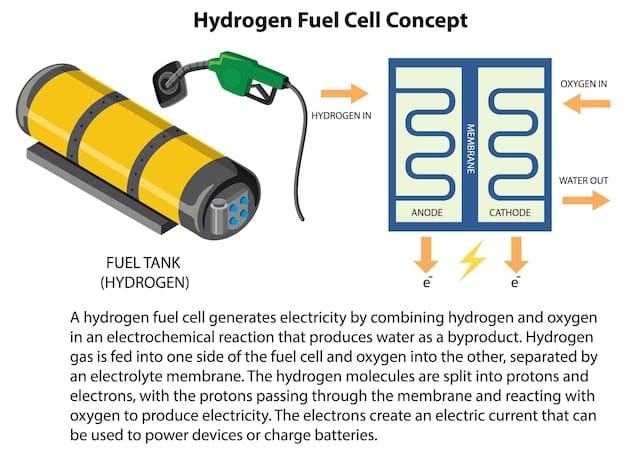Hydrogen Fuel Cell Tech for Transportation: Latest Developments

Hydrogen fuel cell technology for transportation has seen recent advancements including increased efficiency, reduced costs, improved durability, and the development of refueling infrastructure and new materials, paving the way for wider adoption.
What are the latest developments in hydrogen fuel cell technology for transportation? The quest for cleaner and more sustainable energy solutions has put hydrogen fuel cells in the spotlight, particularly in the transportation sector. Recent advancements promise a significant shift towards efficient and eco-friendly vehicles.
Understanding Hydrogen Fuel Cell Technology
Hydrogen fuel cell technology represents a pivotal shift in how we power vehicles, offering a potentially cleaner alternative to traditional combustion engines and battery electric vehicles. It’s important to understand the basic principles behind this technology to appreciate the latest developments.
How Hydrogen Fuel Cells Work
Hydrogen fuel cells operate through an electrochemical reaction, combining hydrogen and oxygen to produce electricity, with water and heat as the primary byproducts. This process is significantly cleaner than burning gasoline, which releases harmful emissions into the atmosphere.
The basic components of a hydrogen fuel cell include an anode, a cathode, and an electrolyte membrane. Hydrogen gas is fed to the anode, where it is separated into protons and electrons. The protons travel through the electrolyte membrane to the cathode, while the electrons are forced to travel through an external circuit, generating electricity.
Benefits of Hydrogen Fuel Cells in Transportation
The benefits of using hydrogen fuel cells in transportation are considerable, ranging from environmental to performance-related advantages. Here are some key points:
- Zero Tailpipe Emissions: Hydrogen fuel cells produce only water vapor as exhaust, eliminating harmful pollutants at the point of use.
- High Energy Efficiency: Fuel cell vehicles can achieve higher efficiency compared to internal combustion engines, translating to better fuel economy.
- Quick Refueling Times: Unlike battery electric vehicles that can take hours to recharge, hydrogen vehicles can be refueled in a matter of minutes, similar to gasoline cars.
- Longer Driving Range: Hydrogen fuel cell vehicles often offer a longer driving range compared to battery electric vehicles, reducing range anxiety for drivers.
In conclusion, hydrogen fuel cell technology offers a promising pathway toward sustainable transportation solutions. Its potential to reduce greenhouse gas emissions, improve energy efficiency, and provide a convenient refueling experience makes it a compelling option for the future of mobility.

Key Advancements in Fuel Cell Efficiency
One of the most significant areas of development in hydrogen fuel cell technology is improving efficiency. Increased efficiency translates directly to better fuel economy, longer driving ranges, and reduced operating costs, making hydrogen vehicles more competitive.
Improved Catalyst Materials
Catalysts play a crucial role in accelerating the electrochemical reactions within a fuel cell. Recent research has focused on developing more effective and durable catalyst materials, often using nanoparticles and novel alloys, to enhance the rate of hydrogen oxidation and oxygen reduction.
These advanced catalysts not only improve the efficiency of the fuel cell but also reduce the amount of precious metals required, such as platinum, which can significantly lower the overall cost of the technology.
Optimized Fuel Cell Design
Fuel cell design is another area where significant advancements have been made. Engineers are working to optimize the structure and configuration of fuel cells to improve gas distribution, heat management, and water removal, all of which contribute to higher efficiency.
Here are several design optimizations currently under development:
- Advanced Membrane Technology: New membrane materials with higher proton conductivity and lower gas permeability are being developed to reduce energy losses and improve overall performance.
- Enhanced Flow Field Design: Optimized flow fields ensure uniform distribution of hydrogen and oxygen across the fuel cell, maximizing the reaction rate and efficiency.
- Integrated Cooling Systems: Efficient cooling systems are essential for maintaining optimal operating temperatures and preventing degradation of fuel cell components.
In summary, improvements in catalyst materials and fuel cell design are driving significant gains in fuel cell efficiency. These advancements are critical for making hydrogen vehicles more practical, cost-effective, and environmentally friendly.
Reducing the Cost of Hydrogen Fuel Cells
Cost reduction is a critical factor in making hydrogen fuel cell technology commercially viable for transportation. High production costs have historically been a barrier to widespread adoption. However, recent developments aim to significantly lower these expenses.

Economies of Scale in Manufacturing
As production volumes increase, manufacturers can achieve economies of scale, reducing the per-unit cost of fuel cell systems. Investments in automated manufacturing processes and streamlined supply chains are crucial for realizing these cost savings.
Lower-Cost Materials
Research efforts are focused on identifying and developing lower-cost materials for fuel cell components, such as membranes, electrodes, and bipolar plates. This includes exploring alternatives to expensive precious metals like platinum.
Government Support and Incentives
Government support, including research grants, tax incentives, and subsidies, plays a vital role in driving down the cost of hydrogen fuel cell technology. These initiatives encourage innovation and investment in the sector.
Examples of financial initiatives being explored include:
- Production Tax Credits: Incentives for hydrogen production can help lower the cost of hydrogen fuel, making it more competitive with gasoline and other fuels.
- Purchase Incentives: Subsidies or tax credits for consumers who purchase hydrogen fuel cell vehicles can help stimulate demand and accelerate market adoption.
- Infrastructure Development Grants: Funding for the construction of hydrogen refueling stations is critical for expanding the refueling network and supporting the growth of the hydrogen vehicle market.
In summary, achieving cost parity with traditional vehicles requires a multi-faceted approach, including economies of scale, lower-cost materials, and strong government support. These developments are making hydrogen fuel cell technology increasingly attractive for the transportation sector.
Enhancements in Fuel Cell Durability and Lifespan
Durability and lifespan are crucial factors for the long-term viability of hydrogen fuel cell vehicles. Enhancements in these areas ensure that fuel cell systems can withstand the rigors of daily use and provide reliable performance over an extended period.
Improved Materials and Components
Advances in materials science are leading to the development of more durable fuel cell components, such as membranes, electrodes, and seals. These materials are designed to resist degradation from chemical reactions, thermal stresses, and mechanical wear.
Advanced Control Systems
Sophisticated control systems monitor and regulate the operating conditions of fuel cells, preventing damage from overheating, overpressure, and other adverse conditions. These systems can optimize fuel cell performance and extend lifespan.
Some key functions of advanced control systems include:
- Temperature Management: Maintaining optimal operating temperatures prevents degradation of fuel cell components and ensures efficient performance.
- Water Management: Controlling the water content within the fuel cell is critical for preventing membrane dehydration or flooding, both of which can reduce performance and lifespan.
- Gas Management: Ensuring a consistent and pure supply of hydrogen and oxygen to the fuel cell is essential for maintaining stable and efficient operation.
By focusing on improved materials and advanced control systems, researchers and engineers are making significant strides in enhancing the durability and lifespan of hydrogen fuel cells.
Development of Hydrogen Refueling Infrastructure
The development of a robust hydrogen refueling infrastructure is essential for supporting the widespread adoption of hydrogen fuel cell vehicles. A lack of refueling stations has been a major barrier to market penetration. However, significant progress is being made in expanding the refueling network.
Public and Private Investment
Both public and private sectors are investing in the development of hydrogen refueling stations. Governments are providing funding and incentives for station construction, while private companies are exploring opportunities to build and operate refueling facilities.
Strategic Station Placement
Refueling stations are being strategically placed in high-traffic areas, such as major transportation corridors and urban centers, to maximize accessibility for hydrogen vehicle owners. This includes partnerships with existing gas stations and convenience stores to integrate hydrogen refueling into existing infrastructure.
On-Site Hydrogen Production
Some refueling stations are equipped with on-site hydrogen production capabilities, using electrolysis or other methods to generate hydrogen from water. This reduces the need for transporting hydrogen from centralized production facilities, lowering costs and improving sustainability.
Consider these benefits of on-site hydrogen production:
- Reduced Transportation Costs: Eliminating the need to transport hydrogen from distant production facilities can significantly lower operating costs for refueling stations.
- Improved Reliability: On-site production ensures a consistent and reliable supply of hydrogen, reducing the risk of supply disruptions.
- Increased Sustainability: Using renewable energy sources, such as solar or wind power, to produce hydrogen on-site can further reduce the environmental impact of hydrogen fuel cell vehicles.
In conclusion, the development of hydrogen refueling infrastructure is critical for enabling the widespread use of hydrogen fuel cell vehicles. Increased investment, strategic station placement, and on-site hydrogen production are key elements in building a comprehensive refueling network.
Materials Science Innovations in Hydrogen Storage
Efficient and safe hydrogen storage is a critical challenge in advancing hydrogen fuel cell technology for transportation. Recent innovations in materials science are addressing this challenge, paving the way for more practical and energy-dense storage solutions.
Advanced Storage Materials
Researchers are exploring novel materials, such as metal hydrides, chemical hydrides, and porous materials, for storing hydrogen at high densities. These materials offer the potential to store more hydrogen in a smaller volume, increasing the driving range of fuel cell vehicles.
Compressed Hydrogen Tanks
Improved designs for compressed hydrogen tanks are also contributing to enhanced storage capacity and safety. These tanks are typically made from lightweight composite materials and are designed to withstand high pressures.
Liquid Hydrogen
Another option is the use of liquid hydrogen, which achieves higher density. However, it has its own challenges such as energy consumption for cooling.
Key storage innovations also include:
- Metal-Organic Frameworks (MOFs): MOFs are porous materials with a high surface area, allowing them to adsorb large amounts of hydrogen.
- Covalent Organic Frameworks (COFs): Similar to MOFs, COFs are crystalline porous materials that can be tailored for specific hydrogen storage applications.
- Nanomaterials: Nanomaterials, such as carbon nanotubes and graphene, offer unique properties for hydrogen storage, including high surface area and tunable porosity.
These advancements in materials science are essential for developing more efficient and practical hydrogen storage solutions, which are critical for the widespread adoption of hydrogen fuel cell vehicles.
| Key Point | Brief Description |
|---|---|
| ✅ Efficiency Boost | Enhanced catalysts and designs improve fuel economy. |
| 💰 Cost Reduction | Manufacturing scale-up and cheaper materials cut expenses. |
| 🔩 Durability | Better materials extend fuel cell lifespan. |
| ⛽ Infrastructure | More refueling stations are being strategically built. |
FAQ
▼
Hydrogen fuel cells primarily emit water vapor, significantly reducing greenhouse gases compared to fossil fuel vehicles, aiding in cleaner air quality and mitigating climate change.
▼
Challenges include high costs, the need for more refueling infrastructure, and improving the efficiency and durability of fuel cell components to compete with other technologies.
▼
Hydrogen fuel cell vehicles can typically be refueled in about the same time it takes to refuel a gasoline car, usually ranging from 3 to 5 minutes.
▼
Innovations like metal hydrides, chemical hydrides, and compressed hydrogen tanks are enhancing storage capacity and safety, improving the viability of hydrogen fuel cell vehicles.
▼
Governments provide crucial support via research grants, tax incentives, and subsidies, fostering innovation and investment. This makes hydrogen fuel cell technology more competitive.
Conclusion
The developments in hydrogen fuel cell technology for transportation highlight a strong move towards sustainability in the automotive industry. Continual advancement will improve efficiency, reduce prices, and improve infrastructure to allow ease of adoption in the future.





